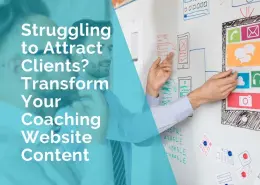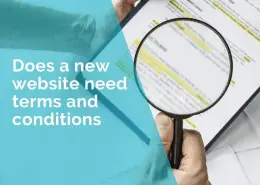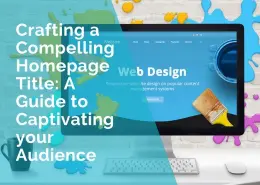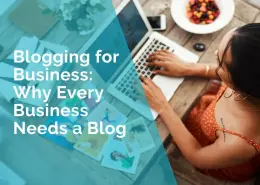The Most Important 41 Pages You Need To Include On Your Website (updated)
1. Home Page
2. Products
3. Services
4. Portfolio/Projects
5. Contact Us
6. Pricing
7. Testimonials/Product Reviews
8. Before & After Gallery
9. FAQ
10. About Us
11. Blog Page
12. Newsletter Signup
13. Resources/Downloads
14. Events Calendar
15. Media
16. Press Releases / Press Kits
17. Case Studies
18. Social Media Feed
19. Rewards/Referral Program
20. Video Tutorials/How-To Guides
21. Links
22. News
23. Online Store
24. Photo Gallery
25. Special Deals & Promotions
26. Terms and Conditions
27. Privacy Policy
28. Shipping & Returns
29. Payment & Security
30. Customer Support
31. Site Map
32. Error 404 Page
33. Search My Website Feature
34. Landing Page
35. Thank You Page
36. Guarantee
37. Survey
38. Accreditation/Certifications
39. Partner/Affiliate Programs
40. Community Services & Sponsorships
41. Appointment Booking
Including the right pages on your website is like building a house with the right rooms.
Just as a house needs a living room, bedrooms, kitchen, and bathrooms to be functional and comfortable, a website needs pages that provide the necessary information and functionality for its users.
Just as you wouldn’t want a house without a bathroom, you wouldn’t want a website without a contact page or an about page.
Including the right pages on your website is essential for creating a user-friendly experience that meets the needs and expectations of your website visitors … the same way as building the right rooms in a house is essential for creating a comfortable and livable space.
Wondering what pages to include on your website and why? Here is a list of important information that should be included as part of your website design.
Before you start thinking about what to write, it is important that you create a plan, which outlines what each page will contain. That way you won’t repeat yourself or forget vital information.
The most common pages on successful websites include:
1. Home Page (First Page)
A homepage is the front door to your website, and it’s often the first point of contact between your website and its visitors. If the homepage looks great and is easy to use, they will be more likely to stick around and explore other pages on your site.
Your homepage should include an easy-to-use navigation system, allowing your visitors to quickly find the information they are looking for. This is especially important for larger websites that have a lot of content.
A well-designed homepage can help establish a website’s brand identity, convey its mission and values, and create an emotional connection with visitors.
It also plays a crucial role in search engine optimization (SEO). A homepage with well-optimized content, meta tags, and keywords can help improve your website’s search engine ranking, making it more visible to potential visitors.
If set up properly, your homepage can also help increase conversion rates by guiding visitors towards the website’s primary goal, whether that is making a purchase, filling out a form, or signing up for a newsletter.
Your homepage should be designed with clear calls-to-action that encourage visitors to take the next step.
Find out about how to create an awesome home page.
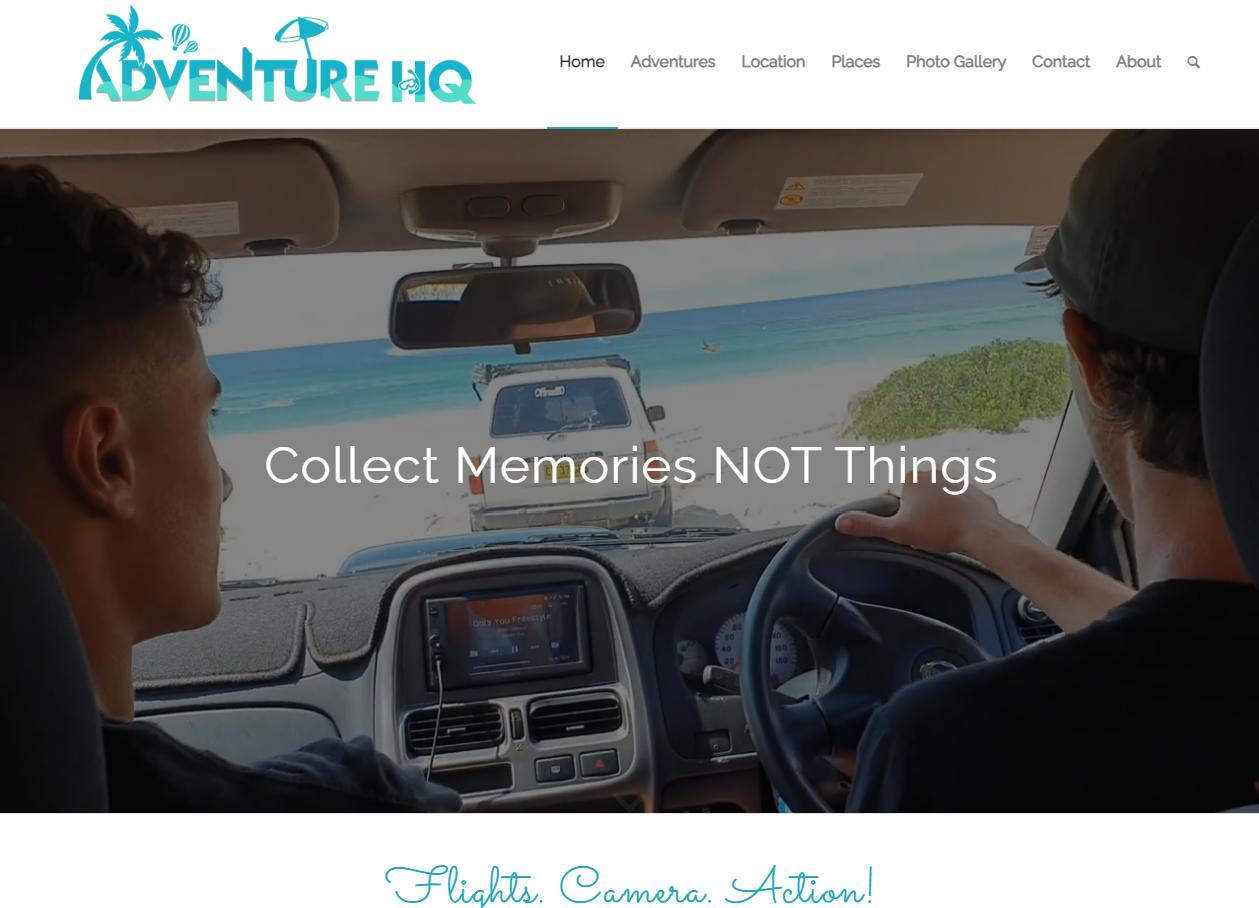
2. Products
A custom Products page is an excellent way to provide detailed information about the products you sell. This can include descriptions, features, specifications, images, videos, and other relevant details that potential customers need to know before making a purchase decision.
A well-organized Products page can help encourage sales by making it easy for customers to find and purchase what they need. It can help them discover new products they were not aware of.
Including calls-to-action buttons, pricing information, and product reviews can help motivate customers to take action and make a purchase.
Discover all the important features you need to include on a Products page.
3. Services
Your services page is where you get to showcase what you have to offer. It’s where potential customers or clients can learn about the services you provide, how you can help them, and why they should choose you over your competitors.
It is useful to have a separate page for each service and write as much detail about each as possible.
So, what should you include on your services page?
Start by outlining what you offer, how your services can benefit your visitors and the problems you solve for them.
It’s also a good idea to include testimonials or case studies from satisfied customers. This social proof can help build trust and credibility with your audience.
And don’t forget to include clear calls-to-action (CTAs) that encourage visitors to take the next step, whether that’s contacting you for more information or making a purchase.
Keep in mind that your services page should be easy to navigate and visually appealing. Use high-quality images and graphics to break up the text and make the page more engaging. And make sure your page is mobile-friendly, as more and more people are browsing the web on their smartphones and tablets.
When people are searching for information on the internet, they want to know it NOW. They don’t want to wait until tomorrow when they can speak to you on the phone. The more information you can provide about your products/services, the better.
4. Porfolio / Projects
Including a portfolio/projects page on your website gives potential clients a glimpse of what you’re capable of and what sets you apart from the competition. This can help you build credibility and trust with your audience.
Your portfolio/projects page is also a chance to tell your professional story. You can highlight your strengths, share your passions, and demonstrate your unique perspective. You might even inspire others to collaborate with you or pursue similar projects.
A portfolio/projects page makes it super easy for people to view and share your work. You can include links to your social media profiles or email signature, making it simple for people to find and connect with you.
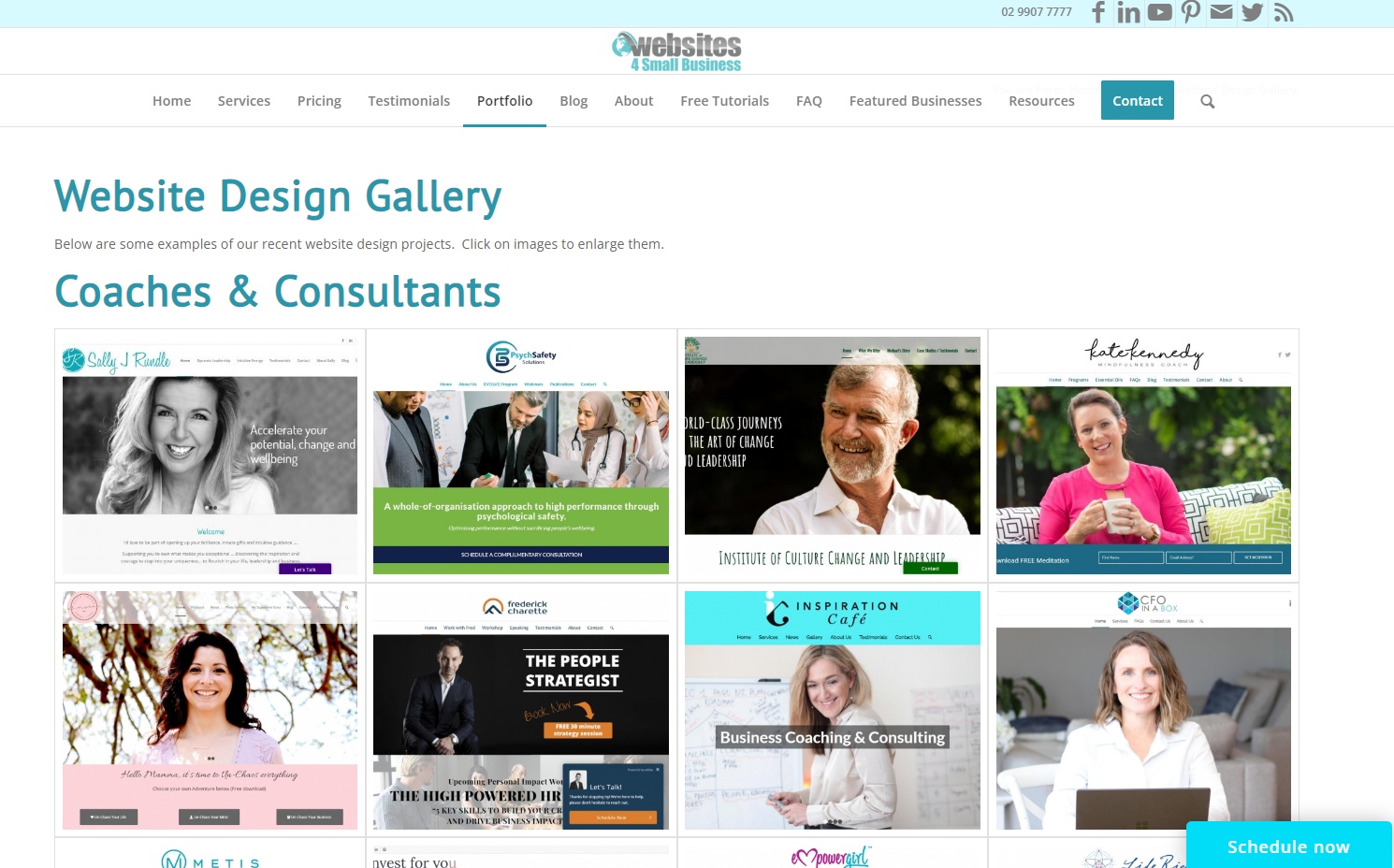
5. Contact Us
Place contact details in as many places as possible and make it easy for your customers to contact you.
Create a special “Contact Us” page, include your details in the “About Us” page and also at the bottom of each page.
There are several ways people might want to contact you, so it’s essential to include multiple options on your Contact Us page.
- Email address
- Phone number – landline as well as your mobile or emergency number
- Links to Social media profiles
- Shop/office address including Google map
- Mailing address:
- Chatbot
- Website address
- Contact form:
Including multiple ways for customers to get in touch with you can help to make it easier for them to reach out and ask questions or get support. This can lead to more positive interactions with your business and can help to build long-lasting relationships with customers.
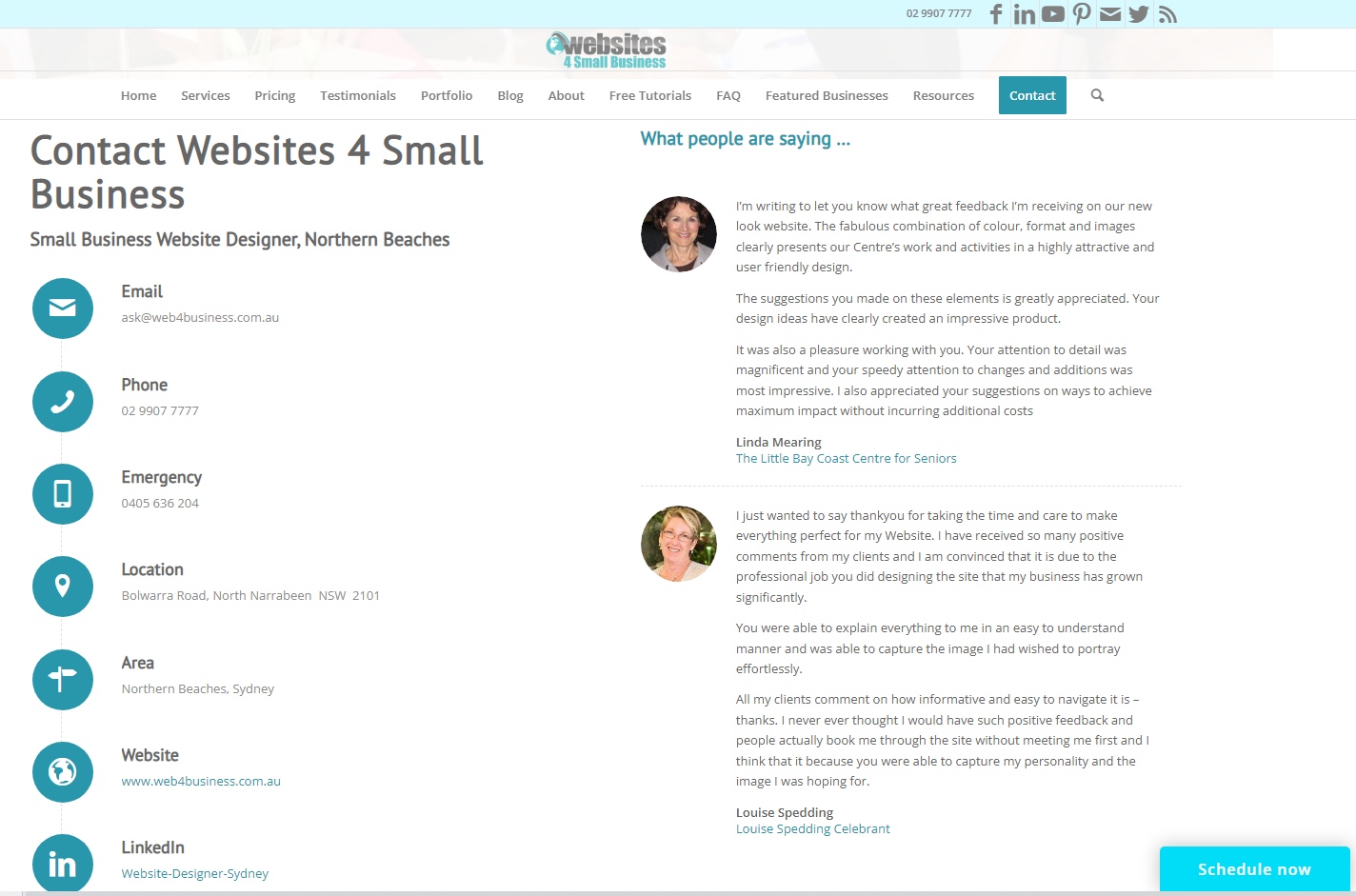
6. Pricing
You may be wondering whether or not to include pricing information on your site. Here are a few reasons why including pricing on your website is so important:
Customers appreciate transparency in pricing, and providing that information upfront can help build trust with your audience. It also sets clear expectations, so there are no surprises when it comes time to make a purchase.
Your visitors can quickly find out whether or not they can afford your products or services, which saves them time and effort.
Including pricing information can set you apart from your competitors. It demonstrates confidence in your offerings and shows that you’re willing to be upfront with your audience.
Here are some types of pricing you may consider including on your website:
Fixed pricing:
This is the most straightforward form of pricing. It involves listing a set price for a product or service.
Tiered pricing:
This type of pricing involves offering different levels of service or features at different price points. For example, a software company may offer a basic plan, a pro plan, and an enterprise plan.
Custom pricing:
Some businesses may offer custom pricing based on a customer’s specific needs. This is often seen in B2B businesses.
Subscription pricing:
This type of pricing involves offering products or services on a recurring basis for a set price. For example, a meal kit delivery service may charge a monthly fee for a certain number of meals.
Pricing by the hour:
This is a common pricing structure used by service-based businesses such as consultants, designers, or lawyers. It allows you to charge for the time you spend on a project and can be more transparent than a flat fee.
Packages:
This involves bundling together several services or products for a set price. Pricing packages can be a great way to encourage customers to buy more from you and provide a more predictable revenue stream for your business.
When including pricing information on your website, be sure to provide context and explain what customers can expect to receive for their money. Consider including a breakdown of features or services included at each price point.
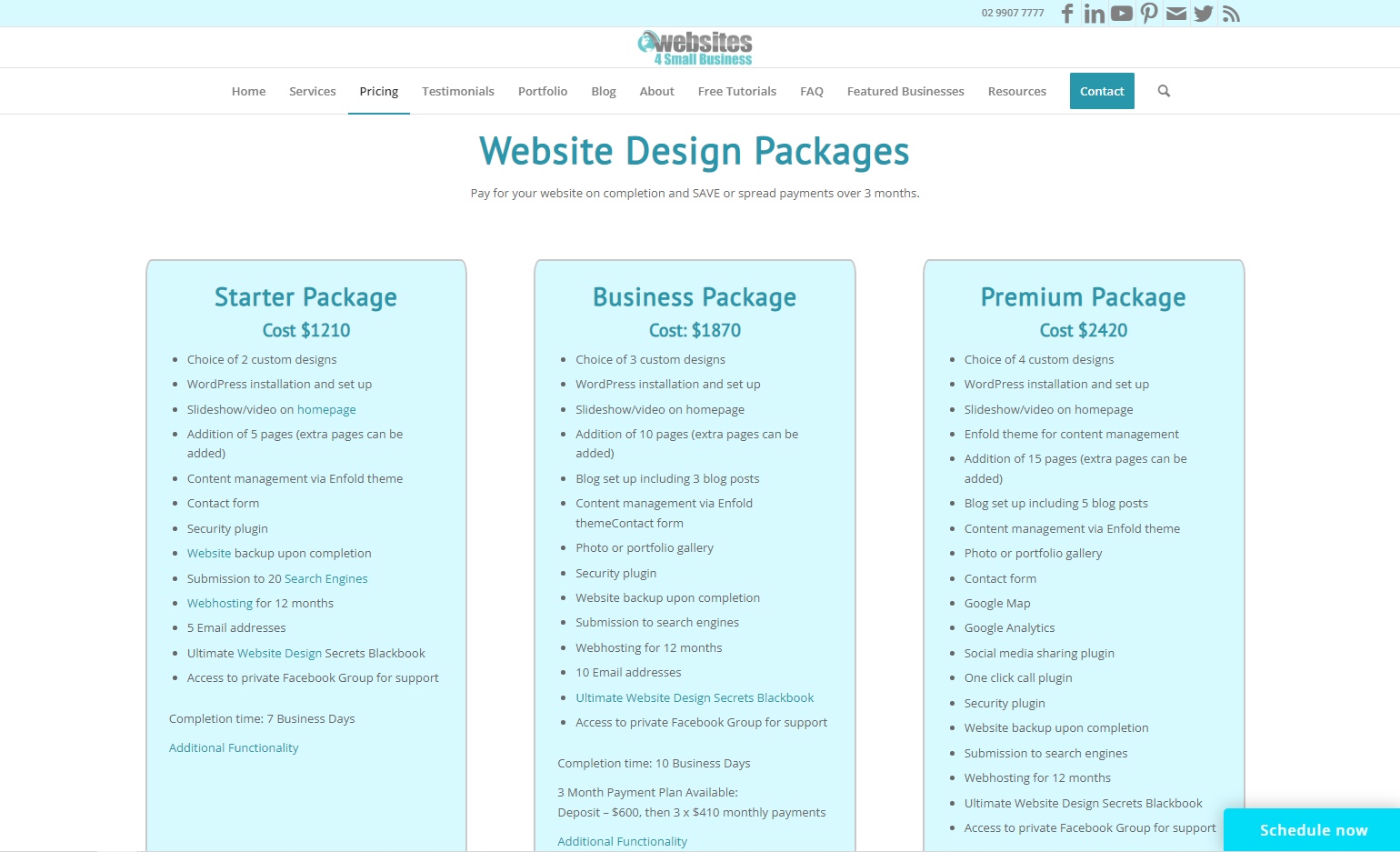
7. Testimonials / Product Reviews
One of the best ways to establish credibility and reliability for your business is by including testimonials from your current customers. It’s important to ensure that the testimonials are genuine and if possible, provide full name, business name and contact details of the person who supplied the information.
Testimonials are usually more detailed and personal, while reviews tend to be shorter and more to the point.
The use of testimonials and reviews on your website can help build trust with potential customers. In fact, studies have shown that over 90% of consumers read online reviews before making a purchase decision!
Having a dedicated Testimonials and Reviews page also provides your customers with a platform to share their experiences with your business, which can be valuable feedback for improving your products or services. Additionally, it shows your customers that you value their opinions and are open to feedback.
So, if you don’t have any testimonials on your website yet, simply email your customers and ask for their feedback on your business and service. Most happy customers will be more than happy to provide this.

8. Before & After Gallery
If you’re running a business that offers a visual transformation, such as a beauty salon, cleaner or carpet cleaner, interior designer, landscaper, home renovation contractor, or fitness coach, then it’s crucial to have a Before & After Gallery on your website.
One of the benefits of a Before & After Gallery is that it can help potential customers visualize the results they can achieve.
For example, if you’re a hairstylist, your Before & After Gallery can showcase the transformations that you have done with haircuts, colour, and styling. This can give customers an idea of what their hair could look like if they were to choose your services.
Similarly, if you’re an interior designer, your Before & After Gallery can showcase how you transformed a room from an outdated space into a modern and stylish one.
Another advantage of a Before & After Gallery is that it can help to build trust with potential clients. By showcasing your work and highlighting your skills and expertise, customers can see that you have experience and knowledge in your field. This can give them the confidence to trust you with their own transformation projects.
A Before & After Gallery can also be a great marketing tool. By sharing your gallery on social media platforms, you can reach a wider audience and showcase your services to potential customers. This can lead to more inquiries and bookings, and ultimately, more business.
9. Frequently Asked Questions
A Frequently Asked Questions page has proven to be a great time saver for many companies. FAQs page should address your customer’s concerns that may otherwise be an obstacle to making a sale. This page can be incredibly helpful for your customers and can make their experience with your business more efficient and enjoyable.
By answering common questions upfront, customers can quickly find the information they need without having to contact you directly. This can save both you and your customers time and effort.
As many customers will go directly to your FAQs page, it’s a good idea to convert your website content to FAQs.
So, what kinds of questions should you include on your FAQs page?
- Shipping and delivery information
- Return and exchange policies
- Payment methods accepted
- Product or service details
- Contact information
- Frequently encountered technical issues
10. About Us
Your About page is where you get to introduce yourself to your audience and share your story. It’s a chance to showcase your personality, values, and expertise. And most importantly, it’s where you build trust and connection with your visitors.
Think about it – when you visit a website for the first time, you want to know who you’re dealing with. Are these people credible? Do they know what they’re talking about? Can I trust them? Your About page is where you answer those questions and show your audience that you’re the real deal.
So, what should you include on your About page?
Start by introducing yourself and your team, if you have one. Share your background, experience, and credentials. This can help establish your expertise and build trust with your audience.
Next, share your values and mission. What drives you? What are you passionate about? This can help your audience connect with you on a deeper level and understand what sets you apart from your competitors.
It’s also a good idea to include some personal details or fun facts about yourself. This can help humanize your brand and make you more relatable to your audience.
And finally, don’t forget to include a clear call-to-action (CTA) at the end of your About page. This could be a link to your products or services, or an invitation to sign up for your newsletter or follow you on social media.
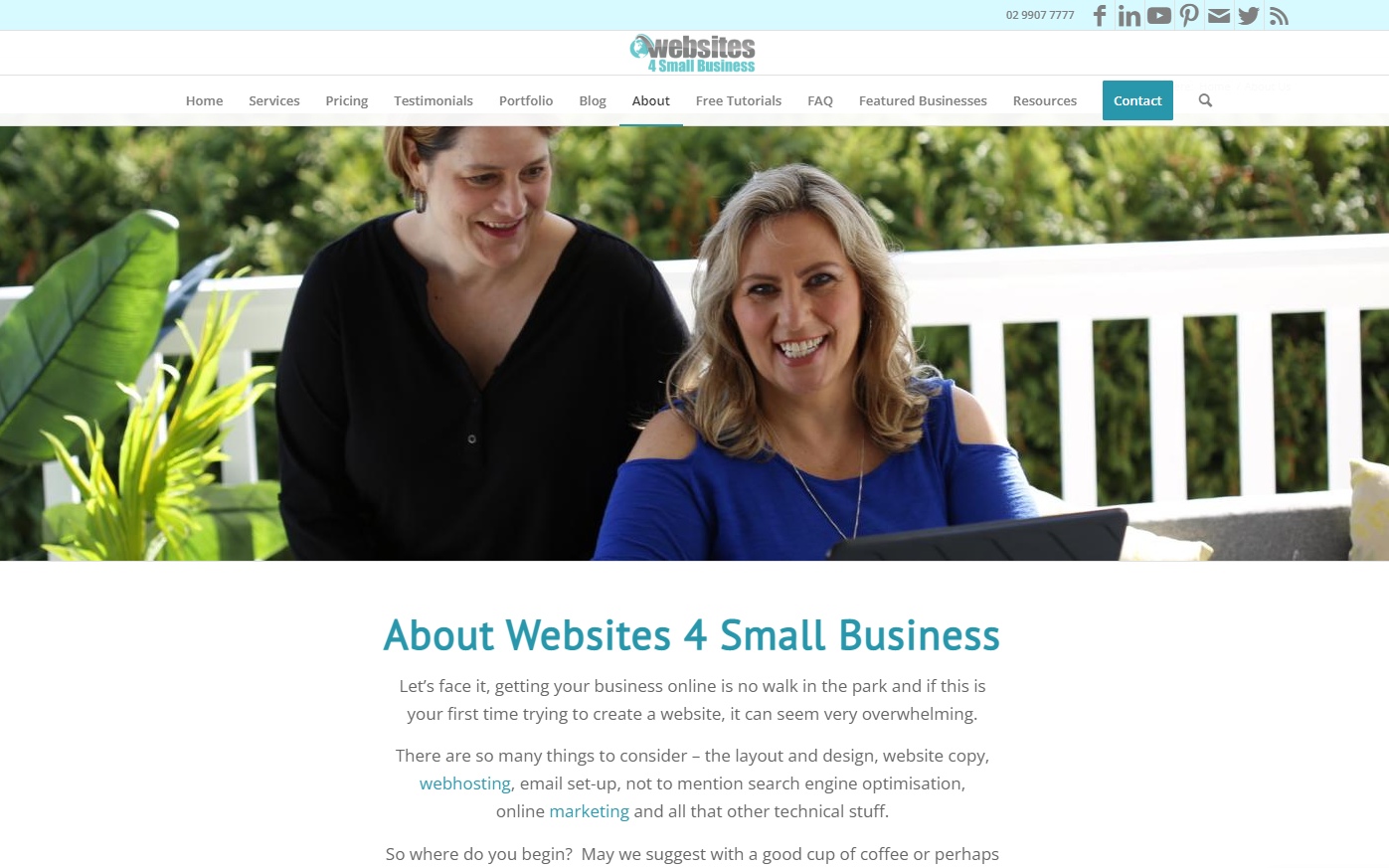
11. Blog
A blog is basically a journal that is available on the web. The activity of updating a blog is “blogging” and someone who keeps a blog is a “blogger.” Blogs are typically updated daily or weekly using software that allows people with little or no technical background to update and maintain the blog.
Blog posts are a great tool as they help with:
Communicating with your customers:
Blogs provide a way for you to communicate with your customers directly. And it is a two-way communication. You can post a message on your blog and your visitors can easily respond. Staying in touch with your customers regularly means you can build long-lasting relationships and develop their trust.
Search Engine Marketing:
Blogs give you an increased presence on major search engines, like Yahoo! and Google. If you use Blogger (Google’s Blogging Tool), every message you post creates a new page on Google so in a very short time you could have a lot of pages pointing to your website, bringing you lots of new visitors.
Stay Ahead of Your Competition:
Blogs are still relatively new and chances are your competition does not yet use them. So you will be seen as an expert in your industry when you post your knowledge and expertise.
Media & Public Relations:
Blogs are excellent PR tools. You can post your Media Releases and articles and have them picked up by the media.
Free or Low-Cost:
Many Blogs are free to use. Two such blogs are: Blogger – www.blogger.com Clearblogs – www.clearblogs.com
Easy to Use:
If you can type and press a “Publish” button, you can use blogging software. The software allows you to follow easy step by step guide and provides great online help.

12. Newsletter Signup
Including a newsletter sign-up page on your website is an important marketing strategy that can help you to grow your audience and keep your customers engaged. A newsletter allows you to communicate directly with your audience, share your latest news, offers, and updates, and promote your products and services.
By encouraging visitors to sign up for your newsletter, you can stay in touch with them long after they’ve left your website. This helps to keep your brand top of mind and can lead to increased sales and customer loyalty over time.
To make the most of your newsletter sign-up page, it’s important to make it as clear and appealing as possible. You’ll want to highlight the benefits of signing up, such as exclusive offers or insider information, and provide a clear call-to-action. This could be as simple as a button that says “Sign up now” or “Subscribe to our newsletter.”
You may also want to offer an incentive for signing up, such as a discount or free download. This can encourage visitors to take action and provide you with their email address.
Once you’ve built your newsletter list, it’s important to send out regular, high-quality content that provides value to your subscribers. This could include updates on your latest products or services, industry news and insights, or helpful tips and advice. By keeping your newsletter content fresh and engaging, you can build a loyal following and keep your audience coming back for more.
13. Resources/Downloads
Including resources and downloads on your website can be a great way to provide additional value to your customers and establish yourself as an authority in your industry. By offering free resources such as ebooks, whitepapers, or templates, you can attract visitors to your website, keep them engaged, and provide them with valuable information that they can use.
These resources can also help to build trust with your audience by demonstrating your expertise and providing a solution to their problems. For example, a financial advisor might offer a free budget template or investment guide, while a software company might offer a free trial or demo of their product.
By providing these resources, you can also encourage visitors to share your content with their own networks, which can help to drive traffic to your website and expand your reach.
It’s important to make these resources easy to find on your website, perhaps by creating a dedicated “Resources” or “Downloads” page. You should also promote them across your social media channels and email campaigns to reach as many people as possible.
In addition to attracting new visitors, these resources can also be a valuable tool for nurturing leads and converting them into customers. By providing free, high-quality original content, you can build trust and credibility with your audience, which can make them more likely to choose your products or services when they’re ready to make a purchase.

14. Events Calendar
An events calendar can help to keep your audience informed and engaged with your brand. Whether you’re hosting events, webinars, or workshops, having a calendar of upcoming events on your website can be a great way to showcase your offerings and encourage participation.
For example, a fitness studio might use an events calendar to promote their weekly yoga classes, while a restaurant might use it to showcase their upcoming wine tastings or special menu nights. A nonprofit organization might use an events calendar to promote their fundraising events, while a tech company might use it to promote their upcoming product launches. If you are a coach or a consultant, you can advertise your webinars and workshops.
By providing an events calendar on your website, you can make it easy for your audience to find out about your events and register or purchase tickets directly on your website. This can streamline the registration process and make it more convenient for your customers, which can encourage them to participate in more of your events.
An events calendar can also help to build excitement and anticipation for your events, by creating a sense of urgency and reminding your audience of the upcoming date. This can help to boost attendance and engagement, which can ultimately lead to more sales or donations for your business.
15. Media Information
Featuring media information on your website is a great way to build credibility and showcase the success of your business. When potential customers see that your business has been featured in reputable media outlets including print, TV, radio, podcasts or other websites, it can help to build trust and encourage them to do business with you.
By including logos and links to media outlets on your website, you can highlight your achievements and show that your business is respected and recognized in your industry. This can help to set you apart from your competitors and position your business as a leader in your field.
Media information can also be helpful for building relationships with journalists and other influencers in your industry. By showcasing your media mentions, you can demonstrate that you are an expert in your field and may be a valuable resource for future stories or features.
Additionally, media information can help to drive traffic to your website and improve your search engine rankings. When reputable media outlets link to your website, it can improve your website’s authority and make it easier for potential customers to find you online.
16. Press Releases / Press Kits
Adding press releases and press kits to your website can be a valuable tool for building relationships with journalists, influencers, and potential customers. A press release is an announcement of a newsworthy event, such as a new product launch, award win, or partnership agreement, while a press kit is a collection of materials that journalists can use to write a story about your business.
By including press releases and press kits on your website, you can make it easy for journalists to access the information they need to write a story about your business. This can help to increase media coverage and raise awareness of your brand. It can also help to establish your business as an expert in your industry and attract potential customers who are interested in your products or services.
17. Case Studies
Including case studies on your website is a great way to showcase your company’s successes and capabilities, and it can be a powerful tool for attracting new clients or customers. Case studies provide real-world examples of how your product or service has helped other businesses or individuals achieve their goals, and can help potential clients understand the value of your offerings.
Here are some reasons why it’s important to include case studies on your website:
Demonstrating expertise and credibility
Case studies demonstrate your expertise in a particular industry or field by highlighting successful projects or partnerships. By showcasing how your company has helped other clients achieve their goals, you’re building credibility and demonstrating your ability to deliver results. This can be particularly important for businesses that offer specialized or technical services.
For example, a marketing agency might include case studies that detail how they helped a client increase website traffic or improve conversion rates through a targeted ad campaign.
Similarly, a software company might showcase case studies that highlight successful implementations of their product in different industries.
Providing social proof
Case studies provide social proof by showing potential clients that your company has a track record of success. By including testimonials or quotes from satisfied clients in your case studies, you’re demonstrating that your business has a positive reputation and is trusted by others in your industry.
For example, a healthcare provider might include case studies that highlight positive patient outcomes or customer satisfaction ratings.
A B2B software company might showcase case studies that demonstrate how their product helped clients save time and money, with testimonials from key decision-makers at those companies.
Differentiating from competitors
Case studies can help your business stand out from competitors by showcasing your unique approach to problem-solving or your ability to deliver exceptional results. By highlighting your successes and demonstrating how your company can solve specific challenges, you’re showing potential clients why they should choose you over your competitors.
For example, a construction company might include case studies that detail complex projects they successfully completed on-time and on-budget.
An education provider might showcase case studies that highlight innovative approaches to teaching and learning, or how they helped students achieve specific academic goals.
18. Social Media Feed
Including a social media feed, such as an Instagram feed, is a great way to enhance the overall user experience and improve engagement with your brand. Here are some reasons why it’s important to include a social media feed on your website:
Increased engagement:
By displaying your Instagram feed on your website, you’re giving your audience the opportunity to engage with your content in a more convenient and accessible way. This can lead to increased engagement and user-generated content, which can help to build a stronger community around your brand.
Improved visual appeal:
Including an Instagram feed on your website can also help to improve the visual appeal of your site. Instagram is a highly visual platform, and by showcasing your best images and videos on your website, you can create a more visually engaging experience for your audience.
Authenticity and transparency:
Social media feeds can help to create a sense of authenticity and transparency around your brand. By showcasing real-time updates from your Instagram account, you’re providing your audience with a glimpse into the behind-the-scenes of your business, which can help to build trust and credibility.
Cross-promotion:
Including an Instagram feed on your website also provides an opportunity for cross-promotion. By showcasing your Instagram content on your website, you can encourage your website visitors to follow your brand on Instagram, which can lead to increased reach and engagement on that platform as well.
19. Rewards/Referral Program
A Rewards/Referral Program page can be a powerful way to incentivize and reward loyal customers, while also attracting new ones. Here are some reasons why it’s important to include a Rewards/Referral Program page on your website:
Increased customer loyalty:
A Rewards/Referral Program can help to increase customer loyalty by offering incentives for repeat purchases. By rewarding customers for their loyalty, you’re more likely to retain their business over time.
Attracting new customers:
A Referral Program allows your existing customers to refer their friends and family to your business, which can be a powerful way to attract new customers. Word-of-mouth referrals are often more effective than traditional advertising, and a Referral Program can help to amplify this effect.
Differentiation from competitors:
Including a Rewards/Referral Program page on your website can help to differentiate your business from competitors. By offering unique incentives and rewards, you can create a more compelling value proposition for your customers.
Improved customer data:
A Rewards/Referral Program can also help to improve your customer data by providing insights into purchasing behaviour and preferences. This data can be used to optimize your marketing efforts and better understand your target audience.
Cost-effective marketing:
A Rewards/Referral Program can be a cost-effective way to market your business. By incentivizing your existing customers to refer their friends and family, you can generate new business without spending a lot of money on advertising.
20. Tutorials/How-to Guides
Tutorials/How-to Guides page on your website can be a powerful way to educate and empower your audience, while also establishing your brand as a thought leader in your industry. Here are some reasons why it’s important to include a Tutorials/How-to Guides page on your website:
Improved customer experience:
Providing tutorials and how-to guides can help to improve the overall customer experience. By providing valuable information and resources, you’re more likely to build trust with your audience and establish your business as a helpful resource.
Increased engagement:
Tutorials and how-to guides can also help to increase engagement with your brand. By providing content that is useful and relevant to your audience, you’re more likely to keep them on your website for longer periods of time and encourage them to come back for more.
Thought leadership:
Including tutorials and how-to guides on your website can help to establish your brand as a thought leader in your industry. By providing valuable insights and expertise, you can position your business as a go-to resource for your target audience.
Search engine optimization:
Tutorials and how-to guides can also help to improve your search engine optimization (SEO) efforts. By providing high-quality content that is optimized for relevant keywords, you’re more likely to rank higher in search engine results pages and attract more organic traffic to your website.
Cost-effective marketing:
Tutorials and how-to guides can be a cost-effective way to market your business. By providing valuable content that is shareable and useful, you can attract new customers and build brand awareness without spending a lot of money on advertising.
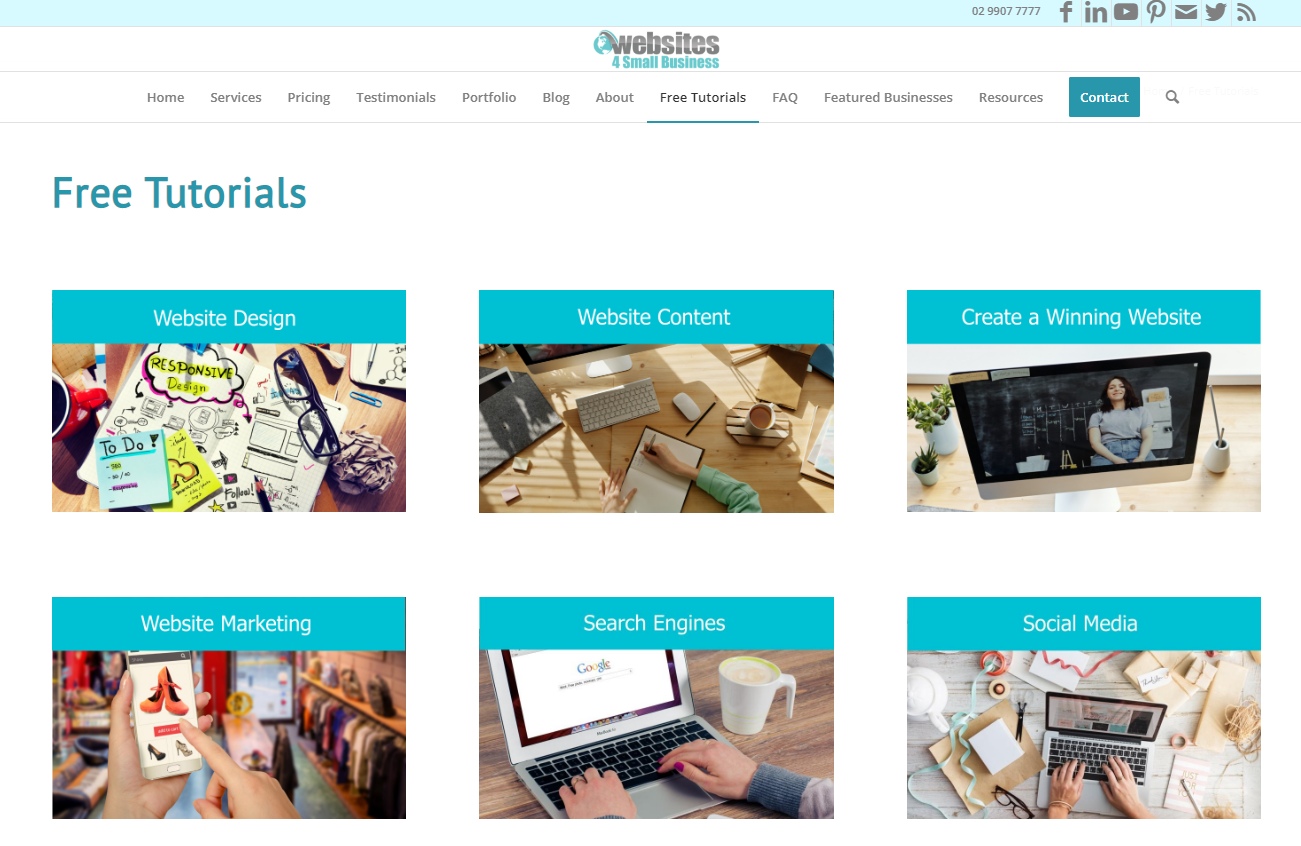
21. Links
Including a Links page on your website can be a valuable way to provide your audience with additional resources and information, while also establishing your business as a helpful and collaborative member of your industry. Here are some reasons why it’s important to include a Links page on your website:
Enhanced credibility:
Including links to other reputable websites and resources can help to enhance your business’s credibility. By showing that you are knowledgeable and well-connected within your industry, you’re more likely to gain the trust of your audience and establish your business as a thought leader.
Improved user experience:
A Links page can also help to improve the overall user experience on your website. By providing additional resources and information, you’re more likely to keep your audience engaged and on your website for longer periods of time.
Collaboration and networking:
Including links to other businesses and organizations in your industry can also help to foster collaboration and networking opportunities. By showcasing your relationships with other businesses and industry leaders, you’re more likely to attract new partnerships and opportunities for growth.
SEO benefits:
A Links page can also provide SEO benefits for your website. By linking to other reputable websites and resources, you’re more likely to improve your search engine rankings and attract more organic traffic to your site.
Brand awareness:
Including links to other businesses and organizations in your industry can also help to increase brand awareness for your business. By showcasing your partnerships and relationships, you’re more likely to attract new customers and establish your business as a respected member of your industry.
22. News
A News page can be a valuable way to keep your audience informed about the latest developments and updates within your business or industry. Here are some reasons why it’s important to include a News page on your website:
First and foremost, a News page can help to establish your business as a credible and reliable source of information. By providing regular updates and insights about your industry or business, you’re more likely to gain the trust and respect of your audience. This, in turn, can help to improve customer loyalty and attract new customers who are looking for a trusted source of information.
Additionally, a News page can help to keep your audience engaged with your business. By providing regular updates and insights, you’re more likely to keep your audience coming back to your website for more. This, in turn, can help to increase your website traffic and improve your overall online presence.
A News page can also provide valuable SEO benefits for your website. By regularly adding fresh and relevant content to your website, you’re more likely to improve your search engine rankings and attract more organic traffic to your site. This, in turn, can help to increase your visibility online and attract new customers to your business.
Furthermore, a News page can help to improve your business’s reputation and brand awareness. By providing updates and insights about your industry or business, you’re more likely to establish your business as a thought leader and respected member of your industry. This, in turn, can help to increase your brand awareness and attract new customers who are looking for a reliable and trustworthy source of information.
23. On-line store
Including an e-commerce store on your website can be a great way to expand your business and reach new customers. Here are some reasons why it’s important to include an online store on your website:
Increased accessibility:
An online store allows customers to shop with your business at any time and from anywhere, increasing your accessibility and convenience.
Expanded customer base:
With an online store, your business is not limited to just local customers. You can now reach customers from all over the world, expanding your customer base and potential sales.
Cost-effective:
Running an online store can be more cost-effective than running a physical store. You don’t have to worry about rent, utilities, or other overhead expenses associated with brick-and-mortar stores.
Increased customer insights:
With an online store, you can track customer behaviour and preferences, allowing you to better tailor your products and services to their needs.
Improved customer experience:
An online store allows customers to easily browse and purchase products from the comfort of their own homes. This can lead to a more positive and enjoyable shopping experience for your customers.
If you’re looking to set up an online store on your website, here are some pages that you may need for the purchasing process:
- Product pages: Each product that you offer for sale should have its own dedicated page, showcasing photos, descriptions, pricing, and other important details.
- Shopping cart: A shopping cart allows customers to add products to their virtual cart as they browse your store, before proceeding to checkout.
- Checkout page: This is where customers enter their shipping and billing information, choose their payment method, and confirm their order.
- Order confirmation page: After the order is submitted, a confirmation page should be displayed, thanking the customer for their purchase and providing details on the next steps.
- Account management: Customers may want to create an account on your website to store their shipping and billing information, view order history, and track the status of their current orders.
- Customer support: In case of any issues or questions, a dedicated customer support page can provide customers with the necessary resources and contact information to resolve their concerns.
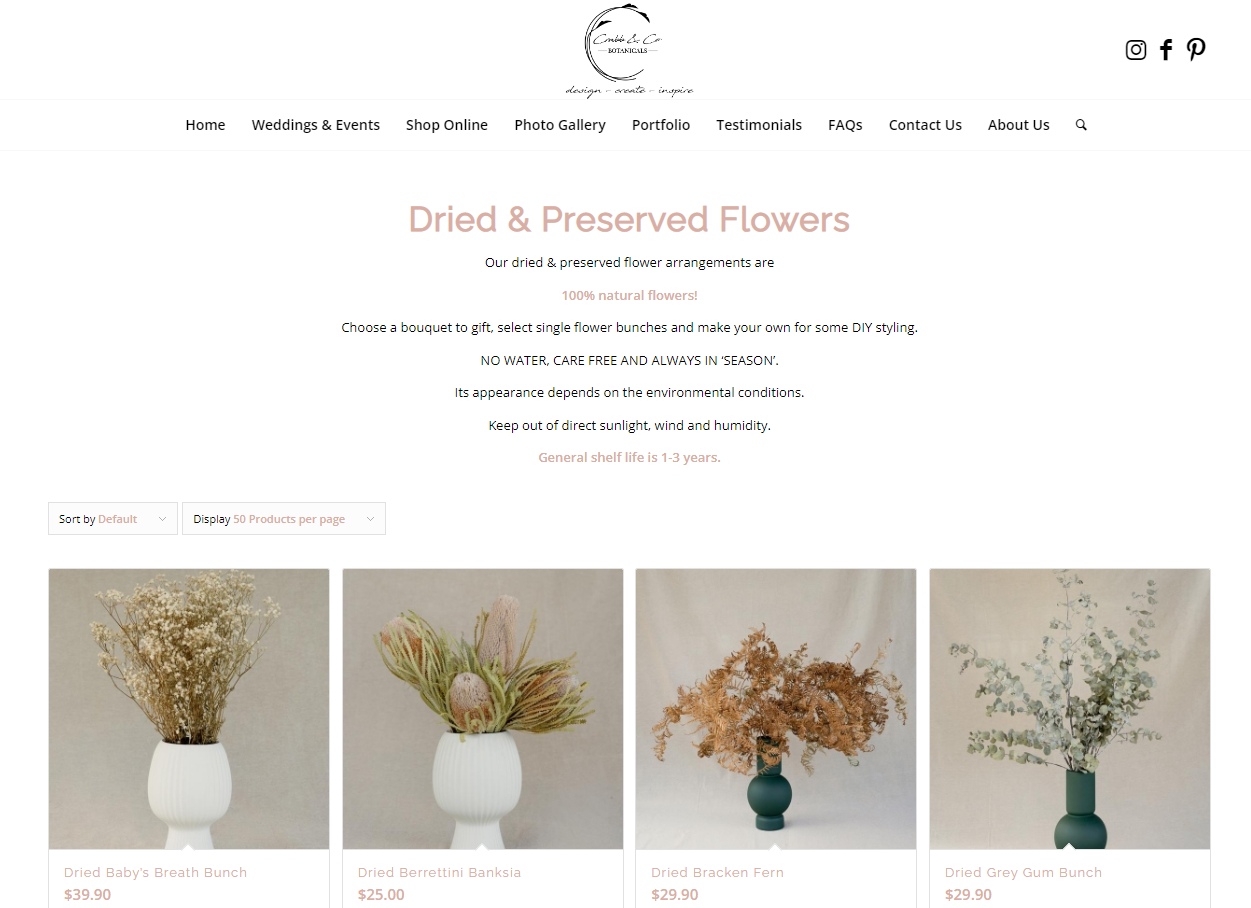
24. Photo Gallery
a photo gallery on your website can be a great way to showcase your products, services, or business in an engaging and visually appealing way. Here are some reasons why it’s important to include a photo gallery on your website:
Engage your audience:
Photos are a great way to grab your audience’s attention and keep them engaged with your website. A well-curated photo gallery can help to showcase your business in a visually appealing way and keep your audience interested in your products or services.
Showcase your products/services:
A photo gallery can be a great way to showcase your products or services and highlight their features and benefits. This can be especially useful for businesses that offer visual products such as clothing, jewelry, or artwork.
Demonstrate your expertise:
A photo gallery can help to demonstrate your expertise and showcase your skills and abilities. For example, if you’re a photographer, you can use a photo gallery to display your portfolio and highlight your best work.
Increase brand awareness:
A photo gallery can help to increase your brand awareness by showcasing your logo, branding, and products or services in a visually appealing way. This can help to reinforce your brand message and make your business more memorable to your audience.
Some examples of photo galleries that you may want to include on your website are:
- Product galleries: If you sell products, consider creating a product gallery that showcases each of your products with high-quality images from different angles. You can also include descriptions and pricing information for each product.
- Portfolio galleries: If you’re a freelancer or creative professional, consider creating a portfolio gallery that showcases your best work. This can include examples of previous projects or collaborations with clients, highlighting your skills and expertise.
- Event galleries: If you host events, consider creating a gallery of photos from each event. This can help to showcase the atmosphere and energy of your events, and provide social proof for potential attendees.
- Behind-the-scenes galleries: Consider creating a behind-the-scenes gallery that provides a glimpse into your business and how you work. This can help to humanize your brand and make it more relatable to your audience.
In summary, including a photo gallery on your website can be a great way to engage your audience, showcase your products or services, demonstrate your expertise, and increase your brand awareness. So if you’re looking to enhance your website’s visual appeal and engage your audience in a more compelling way, consider adding a photo gallery to your website today!
25. Special Deals & Promotions
Special deals and promotions on your website can be a powerful way to attract new customers, retain existing ones, and increase your sales revenue. Here are some reasons why it’s important to include special deals and promotions on your website:
Attract new customers:
Special deals and promotions can be a great way to attract new customers who may not have been aware of your business or may have been hesitant to try your products or services. By offering discounts or special offers, you can entice them to give your business a try.
Retain existing customers:
Special deals and promotions can also help you retain existing customers by providing them with incentives to continue shopping with your business. This can help to build customer loyalty and encourage repeat business.
Increase sales revenue:
Special deals and promotions can help to boost your sales revenue by increasing the number of products or services that you sell. By offering discounts or bundle deals, you can encourage customers to buy more and increase your overall sales.
Create a sense of urgency:
Special deals and promotions can create a sense of urgency among customers, encouraging them to act quickly before the offer expires. This can help to drive immediate sales and increase your conversion rates.
Some examples of special deals and promotions that you may want to include on your website are:
- Discount codes: Offer a discount code that customers can use at checkout to receive a percentage or dollar amount off their purchase.
- Bundle deals: Offer a bundle deal that combines multiple products or services at a discounted price. This can encourage customers to buy more and increase your overall sales revenue.
- Free shipping: Offer free shipping on all orders, or on orders over a certain dollar amount. This can help to incentivize customers to make a purchase and can be especially effective for businesses that sell physical products.
- Limited-time offers: Offer a limited-time promotion that expires within a certain timeframe, creating a sense of urgency and encouraging customers to act quickly.
26. Terms & Conditions
Every website should include a Terms and Conditions (T&C) section to outline the rules and guidelines that users must abide by when using your website. This section serves as a legal agreement between you and your website visitors, so it’s crucial to have a comprehensive T&C that covers all necessary aspects. In this article, we will discuss some of the essential elements that should be included in a website’s T&C.
- Acceptance of Terms
The first section of the T&C should include a statement that users must agree to the terms and conditions before using the website. It should also include a link to the T&C, so users can read and review the agreement.
- User Conduct
The T&C should clearly state what actions are acceptable and what actions are not acceptable on your website. For instance, you may want to prohibit hate speech, spamming, or any other behaviors that could harm your website’s reputation.
- Intellectual Property
It’s essential to protect your website’s content and intellectual property by including a section that outlines the ownership of the website’s content. This may include copyrights, trademarks, and any other intellectual property rights.
- Liability Limitations
A liability limitation section should be included in the T&C to protect your website from legal claims. This section will limit your liability in the event of any losses, damages, or injuries resulting from the use of your website.
- Disclaimer of Warranties
It’s important to include a disclaimer of warranties section that outlines the limitations of your website’s services. This section will inform users that your website does not guarantee any specific results or outcomes.
- Termination
A termination section should be included in the T&C to outline the circumstances under which a user’s account or access to your website may be terminated. This section should also include any consequences of violating the website’s rules and guidelines.
- Changes to the T&C
Finally, it’s important to include a section that outlines how changes to the T&C will be communicated to users. This may include a notification via email or a pop-up message when a user logs in to the website.
27. Privacy Policy
A Privacy Policy is a crucial component of any website as it helps protect the personal information of your website visitors. In today’s digital age, online privacy has become a major concern, and including a Privacy Policy on your website is an effective way to demonstrate your commitment to protecting user data. In this article, we will discuss the essential components that should be included in a Privacy Policy.
- Types of Personal Data Collected
The first section of your Privacy Policy should outline the types of personal data that your website collects from its users. This may include email addresses, names, phone numbers, and other relevant information.
- How the Data is Collected
The next section should outline how the data is collected. For instance, it may be collected through contact forms, cookies, or other tracking technologies.
- Purpose of Data Collection
It’s important to explain the purpose of collecting personal data. For instance, you may need to collect personal information to process orders, provide customer support, or personalize user experiences.
- Use and Disclosure of Personal Data
Your Privacy Policy should outline how you use the personal data collected from users. This may include sharing information with third-party service providers, such as payment processors or shipping companies. You should also include information on how users can opt-out of data sharing or request that their data be deleted.
- Data Security Measures
It’s essential to outline the measures you take to protect user data from unauthorized access, loss, or theft. This may include using encryption technology, secure servers, and regular backups.
- User Rights
Your Privacy Policy should also include information on user rights. This may include the right to access, modify, or delete personal data collected by your website. You may also want to include information on how users can contact you to make data requests.
- Changes to the Privacy Policy
Finally, it’s important to include a section that outlines how changes to the Privacy Policy will be communicated to users. This may include a notification via email or a pop-up message when a user logs in to the website.
28. Shipping & Returns Policy
Including a Shipping and Returns Policy on a website is important for several reasons:
Transparency:
A Shipping and Returns Policy provides clear information to customers about what to expect when they place an order on your website. It helps to build trust and credibility with customers by being transparent about the shipping process and what to do if they need to return an item.
Customer satisfaction:
A clear and fair Shipping and Returns Policy can help to increase customer satisfaction. By providing information upfront, customers are less likely to experience frustration or confusion when their order arrives or if they need to return an item. This can lead to positive reviews, repeat business, and referrals.
Legal protection:
Including a Shipping and Returns Policy on your website can protect you legally. It can help to ensure that you are compliant with consumer protection laws, and it can also help to limit your liability in case of a dispute or legal issue.
Operational efficiency:
Having a clear Shipping and Returns Policy can also help to streamline your operations. By setting clear expectations for shipping and returns, you can reduce the number of inquiries and issues that you need to handle manually. This can save time and resources for your business.
29. Payment & Security
Not only does Payment & Security information help to build trust with your customers, but it also ensures that their personal and financial information is kept safe and secure.
Firstly, by including clear and concise payment information on your website, you are providing your customers with peace of mind that their payment will be processed securely and efficiently. This can be achieved by detailing the payment methods accepted, any fees or charges associated with payment, and outlining the payment process step-by-step.
Additionally, including security information on your website is crucial in establishing trust with your customers. This can be achieved by providing information on the security measures in place to protect their personal and financial information, such as SSL certificates, encryption methods, and any third-party security providers utilized.
By providing comprehensive payment and security information on your website, you are demonstrating your commitment to providing a safe and trustworthy platform for your customers. This not only helps to increase customer confidence and loyalty but also minimizes the risk of fraudulent activities, chargebacks, and payment disputes.
30. Customer Support
A Customer Support page on a website is an essential component of any business’s online presence. It’s where customers can go to find answers to their questions, report issues, and seek help with any problems they may encounter while using your products or services. Here are some key elements that should be included on a comprehensive “Customer Support” page:
Contact Information:
Make sure to include all relevant contact information such as email address, phone number, and live chat support. You can also provide a physical address for customers who prefer to send physical mail.
FAQ Section:
A Frequently Asked Questions (FAQ) section is a great way to provide answers to common customer questions. This can include information about your products or services, shipping policies, and returns.
Troubleshooting Guides:
Provide detailed instructions on how to troubleshoot common issues that customers may experience. This can include step-by-step guides, screenshots, and videos to help customers resolve problems quickly.
Live Chat Support:
Offer live chat support to customers who need immediate assistance. This can be a great way to address any issues or concerns in real-time and provide personalized help to customers.
Customer Feedback:
Provide a way for customers to provide feedback about their experience with your business. This can include a form where customers can leave comments or suggestions or a survey to gauge customer satisfaction levels.
Social Media Links:
Include links to your social media profiles, so customers can follow your business and stay up-to-date with news, promotions, and events.
31. Site Map
A sitemap is essentially a directory of all the pages on your website, which provides an organized, hierarchical overview of your website’s structure. Here are some key reasons why having a sitemap is important:
Improved Navigation:
A sitemap provides an easy-to-use navigational aid for visitors to your website. By providing a clear, organized overview of your website’s structure, visitors can easily find the information they are looking for without having to click through multiple pages.
Search Engine Optimization (SEO):
Search engines like Google use sitemaps to crawl and index the pages on your website. By including a sitemap, you can ensure that all of your website’s pages are properly indexed, which can help to improve your website’s search engine rankings.
Better User Experience:
By providing an organized overview of your website’s structure, a sitemap can help visitors to your website to quickly find the information they need, leading to a better overall user experience.
Improved Accessibility:
A sitemap can also improve the accessibility of your website. For example, visitors with disabilities may use a screen reader to navigate your website, and a sitemap can help to ensure that all pages are accessible in a logical order.
Easy Updates:
A sitemap can also make it easier to update and maintain your website. By providing an overview of all pages on your website, you can easily see which pages need updating or which pages are no longer necessary.
32. Error 404 Page
A 404 error page is shown to users when they attempt to access a page on your website that doesn’t exist. Here are some reasons why having a custom 404 error page is important:
Improve User Experience:
A custom error 404 page can improve the user experience for visitors to your website. Instead of a generic error page, a custom error page can provide helpful information, such as links to popular pages on your website or a search bar, which can help users find the information they’re looking for and keep them on your website.
Maintain Brand Consistency:
A custom error page can maintain brand consistency by incorporating the look and feel of your website. This can help to reinforce your brand identity and make the user feel more comfortable and familiar with your website.
Keep Users on Your Website:
A custom error page can help to keep users on your website, instead of leaving because they can’t find the information they’re looking for. By providing helpful information and links to related content, you can encourage users to continue browsing your website.
Minimize Bounce Rates:
By providing a helpful custom error 404 page, you can reduce bounce rates, which is when users leave your website after viewing only one page. A custom error page can provide visitors with a positive experience, which can help to keep them on your website and reduce bounce rates.
33. Search My Website Feature
A search feature allows visitors to quickly and easily find specific information on your website. Here are some reasons why having a search feature is important:
Better User Experience:
A search feature improves the user experience by making it easy for visitors to find the information they need on your website quickly. This can reduce frustration and increase the likelihood that visitors will stay on your website longer and return in the future.
Easier Navigation:
A search feature can also improve website navigation by allowing visitors to easily find information without having to navigate through multiple pages. This can save visitors time and effort, leading to a better user experience.
Improved Accessibility:
A search feature can also improve accessibility by allowing visitors with disabilities to quickly find the information they need without having to navigate through multiple pages. This can help to ensure that all visitors have access to the same information on your website.
Increased Engagement:
A search feature can also increase engagement on your website by allowing visitors to find information quickly and easily. This can lead to visitors spending more time on your website and engaging with more of your content.
Improved SEO:
A search feature can also improve your website’s SEO by allowing visitors to find information more easily, which can increase the likelihood that they will share your content with others or link to it from their own websites. This can lead to increased traffic to your website and improved search engine rankings.
34. Landing Page
A landing page is a standalone web page designed specifically to convert visitors into leads or customers. Unlike traditional web pages, landing pages have a single goal or call-to-action (CTA), and they are usually free of distractions such as navigation menus or other links.
Landing pages are used in various digital marketing campaigns such as email marketing, pay-per-click advertising, and social media advertising. They are effective in generating leads, increasing conversions, and measuring campaign success.
Here are some examples of landing pages:
Lead generation landing page:
These pages are designed to capture user information such as name and email address. They are commonly used in email marketing campaigns, and they offer something of value to the user in exchange for their information, such as a free guide, eBook, or webinar.
Click-through landing page:
These pages are designed to convince the user to click through to another page to complete a purchase or form submission. They are commonly used in e-commerce campaigns, and they often highlight the benefits of a product or service.
Product launch landing page:
These pages are designed to create buzz and excitement for a new product or service. They often use persuasive language and visuals to encourage users to sign up for more information or pre-order the product.
Event registration landing page:
These pages are designed to promote an upcoming event and encourage users to register. They often include details about the event, a registration form, and social proof such as testimonials or past event photos.
35. Thank You Page
These pages are displayed after a user has completed an action, such as filling out a form or making a purchase. They often thank the user for their action and provide additional information or resources.
36. Guarantee
The primary purpose of a Guarantee page is to instill confidence in the customer that they are making a wise purchase decision. It is where the business can differentiate themselves from their competitors by offering a unique selling proposition, such as a satisfaction guarantee, price match guarantee, or warranty. This page should also address any common concerns or objections that potential customers may have about the product or service.
When creating a Guarantee page, businesses should be clear and concise in their language, using straightforward terms that customers can easily understand. The page should include the following elements:
Explanation of the Guarantee:
Clearly outline the guarantee, including what it covers, any limitations or exclusions, and how customers can claim it.
Benefits of the Guarantee:
Explain how the guarantee benefits the customer, such as risk reduction, peace of mind, or assurance of quality.
Contact Information:
Provide clear contact information, such as an email address, phone number, or contact form, for customers to reach out with any questions or concerns.
Terms and Conditions:
Include a link to the terms and conditions of the guarantee, which should be easily accessible and written in plain language.
37. Survey
Including a survey page on a website can provide several benefits for a business or organization. Here are some reasons why having a survey page on a website can be valuable:
Gather customer feedback:
Surveys allow businesses to gather valuable feedback from customers about their products or services, customer experience, and overall satisfaction. This information can help businesses identify areas for improvement and make data-driven decisions.
Measure customer satisfaction:
Surveys can help businesses measure customer satisfaction and loyalty. By understanding how satisfied customers are with their products or services, businesses can identify areas that need improvement and address customer concerns before they become bigger issues.
Identify customer needs:
Surveys can help businesses identify customer needs and preferences. By understanding what customers are looking for, businesses can tailor their offerings to better meet customer needs and increase customer satisfaction.
Improve customer experience:
Surveys can help businesses improve the customer experience by identifying pain points and areas for improvement. By addressing these issues, businesses can create a better overall experience for customers.
Drive engagement:
Surveys can help businesses drive engagement with customers by soliciting their opinions and feedback. Customers appreciate when businesses value their input, and engaging with them through surveys can help build stronger relationship.
Gather market research:
Surveys can provide businesses with valuable market research. By asking questions about customer demographics, preferences, and behaviours, businesses can gain insights into their target market and make informed decisions about marketing and product development.
38. Accreditation/Certifications
Accreditation or certifications can provide several benefits for a business or organization.
Establish credibility:
Including accreditation or certifications on a website can help establish credibility and build trust with potential customers. It demonstrates that the business or organization has met certain standards and has been recognized by a reputable authority.
Differentiate from competitors:
Accreditation or certifications can help businesses differentiate themselves from their competitors. It demonstrates that the business has gone above and beyond to meet certain standards and provides a level of assurance to customers that they are choosing a reputable provider.
Meet industry standards:
Accreditation or certifications can help businesses meet industry standards and regulatory requirements. This can help ensure that the business is operating in compliance with laws and regulations and can provide a level of assurance to customers that the business is operating ethically and responsibly.
Increase customer confidence:
Including accreditation or certifications on a website can increase customer confidence in the business or organization. It provides a level of assurance that the business is reputable and has met certain standards, which can help customers feel more comfortable choosing to do business with them.
Improve search engine rankings:
Including accreditation or certifications on a website can improve search engine rankings. Search engines often prioritize websites that have accreditation or certifications because they are seen as more reputable and trustworthy.
39. Partner/Affiliate Programs
Partner/affiliate programs are an excellent way for businesses to promote their products and services to a larger audience. Including partner/affiliate programs on a page can provide several benefits for a business or organization.
Firstly, partner/affiliate programs allow businesses to expand their reach by partnering with other businesses. By collaborating with other businesses, a business can access a larger audience and promote their products and services to people who might not have heard of them otherwise. This can be especially valuable for smaller businesses or those in niche industries that might have difficulty reaching a wide audience on their own.
Secondly, partner/affiliate programs provide a source of revenue for businesses. By partnering with other businesses and promoting their products or services, businesses can earn a commission on any sales that are made as a result of their promotion. This can provide an additional stream of income for businesses and can be an effective way to monetize a website.
Thirdly, partner/affiliate programs can help businesses build relationships with other businesses in their industry. By working together to promote each other’s products or services, businesses can build a network of trusted partners and collaborators. This can be valuable for businesses that want to build a strong reputation in their industry and establish themselves as a leader.
Finally, partner/affiliate programs can provide businesses with access to complementary products and services that they can offer to their customers. By partnering with other businesses, businesses can provide their customers with access to additional products and services that they might be interested in. This can help businesses build loyalty with their customers and provide a better overall experience.
40. Community Services & Sponsorships
Including information about community services and sponsorships on a website can have several benefits:
Enhance brand image:
By demonstrating a commitment to the community, a business can enhance its brand image and reputation. This can help to build trust and loyalty with customers, employees, and other stakeholders.
Increase visibility:
By sponsoring local events or charities, a business can increase its visibility in the community. This can help to attract new customers and generate positive word-of-mouth.
Foster community engagement:
By offering community services or volunteer programs, a business can engage with the local community and build meaningful relationships. This can create a sense of goodwill and foster a positive business environment.
Fulfill corporate social responsibility:
Many businesses have a corporate social responsibility (CSR) to give back to the community. Including information about community services and sponsorships on a website demonstrates that the business is fulfilling this responsibility.
41. Appointment Booking
Creating an appointment booking feature on your website has several benefits:
Convenience:
Offering an online appointment booking feature makes it easy for customers to schedule appointments at any time, without having to call during business hours. This can improve customer satisfaction and reduce missed appointments.
Increased efficiency:
By allowing customers to book appointments online, businesses can streamline their scheduling processes and reduce the time and resources required for manual appointment booking.
24/7 Availability:
An online booking feature allows customers to book appointments at any time, even outside of regular business hours. This can help to attract customers who may not be able to call during the day due to work or other commitments.
Improved customer experience:
An appointment booking feature can help to enhance the overall customer experience by reducing wait times and providing more accurate appointment scheduling.
Better management of resources:
By allowing businesses to manage their appointment schedule more efficiently, an online booking feature can help to optimize staff resources and reduce costs.
Competitive advantage:
Offering an appointment booking feature on a website can set a business apart from competitors who may not offer this convenience, making the business more attractive to potential customers.
This page is particularly useful for service based businesses such as coaches and consultants, cleaning businesses, marriage celebrants, doctors, accountants, etc.
Bonus tips:
Copyright Information
Your website should carry a copyright notice to protect its intellectual property. This is generally placed in the footer of your website so it appears on every page and is in the form of:
“Copyright © 2023, Your Company Name”.
List of Pages on a Website
Once you have created your content and submitted it to Google, there are several tools that allow you to check all the pages on your website to ensure they have been indexed correctly.
Having a well-structured website is crucial for any business or organization to succeed in today’s digital age. While there are many types of website, some of the most important ones include the homepage, about us page, products or services page, contact us page, and blog/news section.
The homepage is where visitors land first, and it should provide a clear overview of what your website is about. The about us page should give visitors a sense of your brand’s personality and values. The products or services page should showcase what you offer, and the contact us page should make it easy for visitors to get in touch.
Finally, a blog or news section can help you establish yourself as an authority in your industry and keep visitors engaged with fresh content. By including these pages on your website, you can create a user-friendly experience that helps you attract and retain customers.
*****
 Ivana Katz from Websites 4 Small Business is an award winning web designer who builds websites that build your business. She provides unbeatable web design services to fit your budget.
Ivana Katz from Websites 4 Small Business is an award winning web designer who builds websites that build your business. She provides unbeatable web design services to fit your budget.
The end result? Professional, custom-made sites that give your business the extra oomph it needs to stand out from the competition and make an impact.
Whether you’re a brand-new business or an established one ready to improve your digital presence, Ivana makes it easy to get your business online very quickly. Her websites are professional, tailored to fit your budget, and give your business a serious boost.
Download your FREE copy of “Ultimate Website Design Secrets Blackbook – 10 Bulletproof Strategies for Designing an Outrageously Successful Website”



